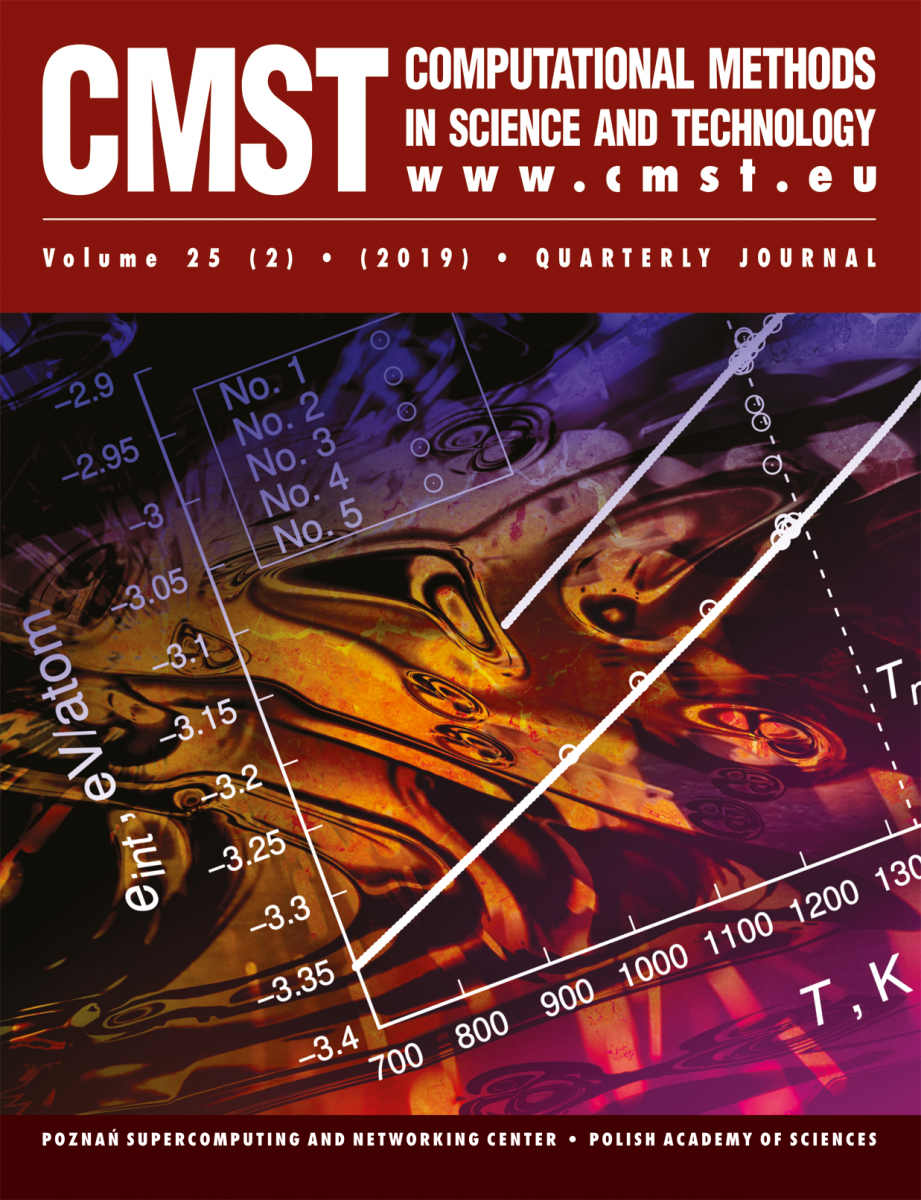Computer Simulations of Poisson’s Ratio of a Simple Periodic Model Structure of Cubic Symmetry – Comparison of Results Obtained by Different Methods
Wojciechowski Krzysztof W. 1,2*, Smardzewski Jerzy 3, Stręk Tomasz 4, Tretiakov Konstantin V. 1,2
1 Institute of Molecular Physics
Polish Academy of Sciences
ul. M. Smoluchowskiego 17, 60-179 Poznań, Poland
∗E-mail: kww@ifmpan.poznan.pl2 President Stanisław Wojciechowski University of Kalisz
Polytechnic Faculty
ul. Nowy Świat 4, 62-800 Kalisz, Poland3 Poznan University of Life Sciences
Faculty of Forestry and Wood Technology
Department of Furniture Design
ul. Wojska Polskiego 28, 60-637 Poznań, Poland4 Poznan University of Technology
Faculty of Mechanical Engineering
Institute of Applied Mechanics
ul. Jana Pawła II 24, 60-965 Poznań, Poland
Received:
Received: 25 November 2024; accepted: 16 December 2024; published online: 20 December 2024
DOI: 10.12921/cmst.2024.0000022
Abstract:
Poisson’s ratio of a periodic model system, based on a cubic crystal with Lennard-Jones interactions, is studied in the direction of the 4-fold axis of the crystal. It is shown that results of atomistic Monte Carlo simulations agree well with results of continuous finite element simulations for systems as small as those built of supercells based on 6 × 6 × 6 unit cells.
Key words:
finite element method, mechanical metamaterials, Monte Carlo simulations, nanocomposites, Poisson’s ratio
References:
[1] L.D. Landau, E.M. Lifshitz, Theory of Elasticity, Pergamon Press, London, UK (1986).
[2] T.C. Lim, Auxetic Materials and Structures, Springer, New York, NY, USA (2015).
[3] R.S. Lakes, Negative Poisson’s ratio materials: Auxetic solids, Annu. Rev. Mater. Res. 47, 63–81 (2017).
[4] R.S. Lakes, Foam Structures with a Negative Poisson’s Ratio, Science 235, 1038–1040 (1987).
[5] K.W. Wojciechowski, Constant thermodynamic tension Monte Carlo studies of elastic properties of a two-dimensional system of hard cyclic hexamers, Mol. Phys. 61, 1247–1258 (1987).
[6] K.W. Wojciechowski, Two-dimensional isotropic model with a negative Poisson ratio, Phys. Lett. A 137, 60–64 (1989).
[7] K.W. Wojciechowski, A.C. Bran´ka, Negative Poisson’s ratio of a two-dimensional “isotropic” solid, Phys. Rev. A 40, 7222–7225 (1989).
[8] K.E. Evans, M.A. Nkansah, I.J. Hutchinson, S.C. Rogers, Molecular network design, Nature 353, 124 (1991).
[9] K.W. Wojciechowski, K.V. Tretiakov, M. Kowalik, Elastic properties of dense solid phases of hard cyclic pentamers and heptamers in two dimensions, Phys. Rev. E 67, 036121 (2003).
[10] J.W. Narojczyk, K.V. Tretiakov, J. Smardzewski, K.W. Wojciechowski, Hardening of fcc hard-sphere crystals by introducing nanochannels: Auxetic aspects, Phys. Rev. E 108, 045003 (2023).
[11] J.W. Narojczyk, Increase in Auxeticity Due to the Presence of a Disordered Crystalline Phase of Hard Dumbbells Within the Nanolayer–Nanochannel Inclusion Introduced to the f.c.c. Hard Sphere Crystal, Materials 16, 5558 (2024).
[12] J.W. Narojczyk, K.W. Wojciechowski, Elastic properties of hard sphere crystals with tripple (001) nanolayer inclusions within a unit supercell, CMST 30, 49 (2024).
[13] M. Parrinello, A. Rahman, Polymorphic transitions in single crystals: A new molecular dynamics method, J. Appl. Phys. 52, 7182–7190 (1981).
[14] M. Parrinello, A. Rahman, Strain fluctuations and elastic constants, J. Chem. Phys. 76, 2662–2666 (1982).
[15] COMSOL Multiphysics® 5.5, Structural Mechanics Module, https://www.comsol.com/release/5.5.
[16] Abaqus (Dynamic, Explicit) v.6.13-1.
Poisson’s ratio of a periodic model system, based on a cubic crystal with Lennard-Jones interactions, is studied in the direction of the 4-fold axis of the crystal. It is shown that results of atomistic Monte Carlo simulations agree well with results of continuous finite element simulations for systems as small as those built of supercells based on 6 × 6 × 6 unit cells.
Key words:
finite element method, mechanical metamaterials, Monte Carlo simulations, nanocomposites, Poisson’s ratio
References:
[1] L.D. Landau, E.M. Lifshitz, Theory of Elasticity, Pergamon Press, London, UK (1986).
[2] T.C. Lim, Auxetic Materials and Structures, Springer, New York, NY, USA (2015).
[3] R.S. Lakes, Negative Poisson’s ratio materials: Auxetic solids, Annu. Rev. Mater. Res. 47, 63–81 (2017).
[4] R.S. Lakes, Foam Structures with a Negative Poisson’s Ratio, Science 235, 1038–1040 (1987).
[5] K.W. Wojciechowski, Constant thermodynamic tension Monte Carlo studies of elastic properties of a two-dimensional system of hard cyclic hexamers, Mol. Phys. 61, 1247–1258 (1987).
[6] K.W. Wojciechowski, Two-dimensional isotropic model with a negative Poisson ratio, Phys. Lett. A 137, 60–64 (1989).
[7] K.W. Wojciechowski, A.C. Bran´ka, Negative Poisson’s ratio of a two-dimensional “isotropic” solid, Phys. Rev. A 40, 7222–7225 (1989).
[8] K.E. Evans, M.A. Nkansah, I.J. Hutchinson, S.C. Rogers, Molecular network design, Nature 353, 124 (1991).
[9] K.W. Wojciechowski, K.V. Tretiakov, M. Kowalik, Elastic properties of dense solid phases of hard cyclic pentamers and heptamers in two dimensions, Phys. Rev. E 67, 036121 (2003).
[10] J.W. Narojczyk, K.V. Tretiakov, J. Smardzewski, K.W. Wojciechowski, Hardening of fcc hard-sphere crystals by introducing nanochannels: Auxetic aspects, Phys. Rev. E 108, 045003 (2023).
[11] J.W. Narojczyk, Increase in Auxeticity Due to the Presence of a Disordered Crystalline Phase of Hard Dumbbells Within the Nanolayer–Nanochannel Inclusion Introduced to the f.c.c. Hard Sphere Crystal, Materials 16, 5558 (2024).
[12] J.W. Narojczyk, K.W. Wojciechowski, Elastic properties of hard sphere crystals with tripple (001) nanolayer inclusions within a unit supercell, CMST 30, 49 (2024).
[13] M. Parrinello, A. Rahman, Polymorphic transitions in single crystals: A new molecular dynamics method, J. Appl. Phys. 52, 7182–7190 (1981).
[14] M. Parrinello, A. Rahman, Strain fluctuations and elastic constants, J. Chem. Phys. 76, 2662–2666 (1982).
[15] COMSOL Multiphysics® 5.5, Structural Mechanics Module, https://www.comsol.com/release/5.5.
[16] Abaqus (Dynamic, Explicit) v.6.13-1.

